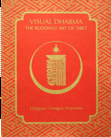Mandalas
and Stupas
Mandalas
The basic form of a mandala is a palace with a center and four gates
in the four directions. It should be understood that mandala representations
are not used as objects of contemplation in an attempt to bring
about  certain
states of mind. Mandalas are used by practitioners who have been
introduced into the practice of particular sadhanas as a sort of
shrine on which to place ritual objects. The ritual objects such
as vajra, bell (S.: ghanta), skullcup, etc., are placed on certain
parts of the mandala in order to magnetize to it the particular
deity whose attributes the objects are. certain
states of mind. Mandalas are used by practitioners who have been
introduced into the practice of particular sadhanas as a sort of
shrine on which to place ritual objects. The ritual objects such
as vajra, bell (S.: ghanta), skullcup, etc., are placed on certain
parts of the mandala in order to magnetize to it the particular
deity whose attributes the objects are.
There
are four traditional ways of representing mandalas: with colored
sand; with five heaps of grain for the center and the four directions;
by painting; by casting a three-dimensional mandala in metal.
The
four directions are called east, south, west and north, but in practice
they have a more personal sense. The practitioner identifies himself
with the deity whose dwelling place is at the center of the mandala
and the directions become his front, his right, his back, his back,
his left, with east being the front. Two-dimensional representations
of mandalas are aerial views. One sees four gates in the four primary
directions and messengers and subprinciples of various kinds emanating
out from the central figure, usually in the eight directions. (The
eight directions actually stand for ten directions, by including
up and down.) The mandala is, in the case of wrathful yidams, surrounded
by a charnel ground, the place of birth and death, recognizable
often by depictions of corpses, innards and severed limbs. The charnel
ground is the basic earth on which the mandala is built. It represents
the world as a rubbish pile of existence, which has been consecrated.
It also represents the all-pervasiveness of impermanence. Outside
that is a further circle of flames in five colors signifying the
five wisdoms. This demarcates and keeps safe the area of the mandala.
Stupas

Stupas (T.: choten, Tt.: mchod rten) are three-dimensional forms
representing the body, speech and mind of Buddha. They vary in size
from altarpieces to huge monumental structures that can be seen
for miles. Probably the oldest form of Buddhist art, they are repositories
of sacred relics and texts and objects of simple, straightforward
veneration for the teachings of Buddha. Those of any size are venerated
by circumambulation, which sometimes may go on for days.
There
are many variations in the design of stupas. The basic features
common to most are, from the btoom; a square base; a domelike form;
thirteen tapering, round steps; a lotus form; a sun held by the
crescent moon. These features can be seen as representing the five
elements – earth, water, fire, air, space – as well
as various aspects of the Buddhist path.
back
to top
...........................................................................................................................................................................................................
Essay © 1975 Chogyam Trungpa Rinpoche
copyright © 2003 Shelly and Donald Rubin Foundation
|

